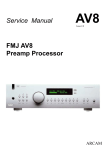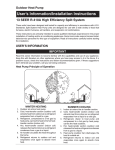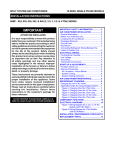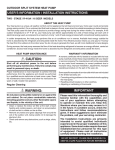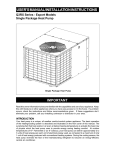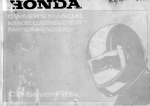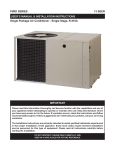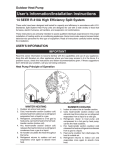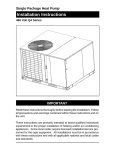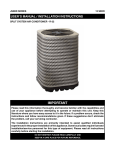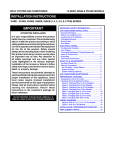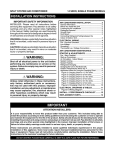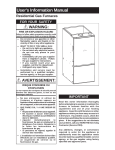Download Winchester 4RAC36Q17-30 Instructions / Assembly
Transcript
NS6QD SERIES - WITH QUICK CONNECT COUPLINGS 13 SEER USER’S MANUAL / INSTALLATION INSTRUCTIONS OUTDOOR SPLIT SYSTEM AIR CONDITIONER FOR MANUFACTURED HOUSING IMPORTANT Please read this information thoroughly and become familiar with the capabilities and use of your appliance before attempting to operate or maintain this unit. Keep this literature where you have easy access to it in the future. If a problem occurs, check the instructions and follow recommendations given. If these suggestions don’t eliminate your problem, call your servicing contractor. The Installation Instructions are primarily intended to assist qualified individuals experienced in the proper installation of this appliance. Some local codes require licensed installation/service personnel for this type of equipment. Please read all instructions carefully before starting the installation. DO NOT DESTROY. PLEASE READ CAREFULLY AND KEEP IN A SAFE PLACE FOR FUTURE REFERENCE. USER INFORMATION Important Safety Information ....................................3 WARRANTY INFORMATION Operating Instructions ...............................................3 Cooling Operation .....................................................3 Heating Operation .....................................................3 Operating the Air Conditioner for Automatic Cooling and Heating ..................................................3 Operating the Indoor Blower Continuously ................3 Turning the Air Conditioner Off ..................................3 A warranty certificate with full details is included with the air conditioner. Carefully review these responsibilities with your dealer or service company. The manufacturer will not be responsible for any costs found necessary to correct problems due to improper setup, improper installation, adjustments, improper operating procedure on the part of the user, etc. Some specific examples of service calls which are not included in the limited warranty are: • Correcting wiring problems in the electrical circuit supplying the air conditioner. • Resetting circuit breakers or other switches. • Adjusting or calibrating of thermostat. Air Conditioner Maintenance.................................... 3 Troubleshooting......................................................... 3 INSTALLER INFORMATION Important Safety Information ....................................4 Air Conditioner Maintenance.....................................9 Air Conditioner Installation .......................................5 General Information...................................................5 Before You Install this Unit .........................................5 Locating the Air conditioner .......................................5 Packaging Removal ...................................................5 Ground Level .............................................................5 Connecting Refrigerant Tubing Between the Indoor & Outdoor Unit ...............................................6 Component Functions ...............................................9 Electrical Wiring..........................................................6 Pre - Electrical Checklist ...........................................6 Line Voltage ...............................................................7 Grounding..................................................................7 Thermostat Connections ...........................................7 Startup & Adjustments ..............................................8 Pre - Start Checklist ..................................................8 Start-up Procedures ..................................................8 Air Circulation - Indoor Blower ...............................8 System Cooling ......................................................8 System Heating ......................................................8 Refrigerant Charging .................................................8 Charging R-410A Units in AC Mode with Outdoor Temperatures Above 55° F.......................8 2 Replacement Parts .....................................................9 Figures & Tables ....................................................... 10 Figure 4. Unit Dimensions .................................... 10 Table 4. Electrical Specs & Physical Data ............ 11 Figure 5. Wiring Diagram - 2 - 2.5 Ton Units ........ 12 Figure 6. Wiring Diagram - 3 Ton Units ................ 13 Figure 7. Wiring Diagram - 3.5 - 5 Ton Units ........ 14 Cooling Charging Charts ......................................... 15 Figure 8. Charging Chart for 2 Ton Units .............. 16 Figure 9. Charging Chart for 2.5 Ton Units ........... 16 Figure 10. Charging Chart for 3 Ton Units ............ 17 Figure 11. Charging Chart for 3.5 Ton Units ......... 17 Figure 12. Charging Chart for 4 Ton Units ............ 18 Figure 13. Charging Chart for 5 Ton Units ............ 18 INSTALLATION / PERFORMANCE CHECKLIST ..... 20 USER INFORMATION IMPORTANT SAFETY INFORMATION Safety markings are used frequently throughout this manual to designate a degree or level of seriousness and should not be ignored. WARNING indicates a potentially hazardous situation that if not avoided, could result in personal injury or death. CAUTION indicates a potentially hazardous situation that if not avoided, may result in minor or moderate injury or property damage. The continuous indoor blower operation can be obtained with the thermostat system mode set in any position, including OFF. Turning the Air Conditioner OFF Change the thermostat’s system mode to OFF and the fan mode to AUTO (See Figure 1). NOTE: The system will not operate, regardless of the temperature selector setting. OPERATING INSTRUCTIONS NOTE: Thermostat styles vary. Some models may not include the AUTO mode and others will have the AUTO in place of the HEAT and COOL. Others may include all three. Please refer to the thermostat manufacturer’s User manual for detailed programming instructions. Cooling Operation 1. Set the thermostat’s system mode to COOL or AUTO and change the fan mode to AUTO. See Figure 1. 2. Set the temperature selector to the desired temperature level. The outdoor fan, compressor, and blower motor will all cycle on and off to maintain the indoor temperature at the desired cooling level. NOTE: If the temperature level is re-adjusted, or the system mode is reset, the fan and compressor in the outdoor unit may not start immediately. A protective timer circuit holds the compressor and the outdoor fan off for approximately 5 minutes following a previous operation or the interruption of the main electrical power (if applicable). Heating Operation 1. Set the thermostat’s system mode to HEAT or AUTO and change the fan mode to AUTO. See Figure 1. 2. Set the temperature selector to the desired temperature level. The optional heating equipment (furnace or electric heat) will cycle on & off to maintain the indoor temperature at the desired temperature level. Operating the AC for Automatic Cooling & Heating 1. Set the thermostat system mode to AUTO and the thermostat fan mode to AUTO. See Figure 1. 2. Set the thermostat temperature selector to the desired temperature level. The thermostat will maintain the desired temperature level by switching between either the outdoor cooling unit or the indoor heating unit (furnace or electric heat) automatically. Operating the Indoor Blower Continuously The continuous indoor blower operation is typically used to circulate the indoor air to equalize a temperature unbalance due to a sun load, cooking, or fireplace operation. Set the thermostat fan mode to ON (Figure 1). The indoor blower starts immediately, and will run continually until the fan mode is reset to AUTO. Fan Mode System Mode Temperature Selector Figure 1. Digital Thermostat AIR CONDITIONER MAINTENANCE Proper maintenance is most important to achieve the best performance from the appliance and should be performed frequently at the beginning of each air conditioning season. WARNING: Your Air Conditioner contains liquid and gaseous refrigerant under pressure. Installation and servicing should only be attempted by qualified, trained personnel thoroughly familiar with the equipment and safe responsible refrigerant handling procedures. Failure to comply with this warning could result in equipment damage, personal injury, or death. • • • Keep the outdoor unit clean. Hose off periodically and keep unit fins clear of leaves and grass clippings. Keep the outdoor unit clear of obstructions. DO NOT obstruct airflow with tall plants or shrubs. DO NOT store gasoline or other flammable materials on or near the outdoor unit. Never operate the appliance without a filter installed in the return air duct. Inspect filters frequently and replace when necessary with filter of same dimensional size. TROUBLESHOOTING • • • • Check the thermostat setting. Make sure the system mode and temperature settings are correct. Check the electrical panel for tripped circuit breakers. Check the filters for dust accumulation. Check the outdoor unit and make sure it is clean and not covered with grass or leaves. 3 INSTALLER INFORMATION IMPORTANT SAFETY INFORMATION INSTALLER: Please read all instructions before servicing this equipment. Pay attention to all safety warnings and any other special notes highlighted in the manual. Safety markings are used frequently throughout this manual to designate a degree or level of seriousness and should not be ignored. WARNING indicates a potentially hazardous situation that if not avoided, could result in personal injury or death. CAUTION indicates a potentially hazardous situation that if not avoided, may result in minor or moderate injury or property damage. WARNING: Shut off all electrical power to the unit before performing any maintenance or service on the system. Failure to comply may result in personal injury or death. WARNING: Unless noted otherwise in these instructions, only factory authorized parts or accessory kits may be used with this product. Improper installation, service, adjustment, or maintenance may cause explosion, fire, electrical shock or other hazardous conditions which may result in personal injury or property damage WARNING: NS6QD Split System Air conditioners leave the factory with an R-410A refrigerant holding charge. Follow all charging instructions for maximum unit performance and efficiency. Some local codes require licensed installation/service personnel to service this type of equipment. Refrigerant charging must be done by qualified personnel familiar with safe and environmentally responsible refrigerant handling procedures. Under no circumstances should the owner attempt to install and/or service this equipment. Failure to comply with this warning could result in property damage, personal injury, or death. 4 CAUTION: This unit uses refrigerant R-410A. DO NOT use any other refrigerant in this unit. Use of another refrigerant will damage the unit. WARNING: The information listed below must be followed during the installation, service, and operation of this unit. Unqualified individuals should not attempt to interpret these instructions or install this equipment. Failure to follow safety recommendations could result in possible damage to the equipment, serious personal injury or death. • The installer must comply with all local codes and regulations which govern the installation of this type of equipment. Local codes and regulations take precedence over any recommendations contained in these instructions. Consult local building codes and the National Electrical Code (ANSI CI) for special installation requirements. • All electrical wiring must be completed in accordance with local, state and national codes and regulations and with the National Electric Code (ANSI/NFPA 70) or in Canada the Canadian Electric Code Part 1 CSA C.22.1. • This equipment contains liquid and gaseous refrigerant under high pressure. DO NOT USE ANY PORTION OF THE CHARGE FOR PURGING OR LEAK TESTING. Installation or servicing should only be performed by qualified trained personnel thoroughly familiar with this type equipment. • Fully annealed, refrigerant grade copper tubing should be used when installing the system. Refrigerant suction line tubing should be fully insulated. • Installation of equipment may require brazing operations. Installer must comply with safety codes and wear appropriate safety equipment (safety glasses, work gloves, fire extinguisher, etc.) when performing brazing operations. • Follow all precautions in the literature, on tags, and on labels provided with the equipment. Read and thoroughly understand the instructions provided with the equipment prior to performing the installation and operational checkout of the equipment. AIR CONDITIONER INSTALLATION General Information The NS6QD series air conditioner is designed only for outdoor rooftop or ground level installations. This unit has been tested for capacity and efficiency in accordance with A.H.R.I. Standards and will provide many years of safe and dependable comfort, providing it is properly installed and maintained. Abuse, improper use, and/or improper maintenance can shorten the life of the appliance and create unsafe hazards. To achieve optimum performance and minimize equipment failure, it is recommended that periodic maintenance be performed on this unit. The ability to properly perform maintenance on this equipment requires certain mechanical skills and tools. Before You Install this Unit The cooling load of the area to be conditioned must be calculated and a system of the proper capacity selected. It is recommended that the area to be conditioned be completely insulated and vapor sealed. Check the electrical supply and verify the power supply is adequate for unit operation.The system must be wired and provided with circuit protection in accordance with local building codes. If there is any question concerning the power supply, contact the local power company. The indoor section (air handler, furnace, etc) should be installed before routing the refrigerant tubing. Refer to the indoor unit's installation instructions for installation details. All units are securely packed at the time of shipment and upon arrival should be carefully inspected for damage prior to installing the equipment at the job site. Verify coil fins are straight. If necessary, comb fins to remove flattened or bent fins. Claims for damage (apparent or concealed) should be filed immediately with the carrier. Please consult your dealer for maintenance information and availability of maintenance contracts. Please read all instructions before installing the unit. 18" DO NOT OBSTRUCT TOP OF UNIT Locating the Air Conditioner • Survey the job site to determine the best location for mounting the outdoor unit. See Figure 4 (page 10) for unit dimensions. • Overhead obstructions, poorly ventilated areas, and areas subject to accumulation of debris should be avoided. • Sufficient clearance for unobstructed airflow through the outdoor coil must be maintained in order to achieve rated performance. For minimum clearances to obstructions, see Figure 2. • Consideration should be given to availability of electric power, service access, noise, and shade. Packaging Removal NOTE: To prevent damage to the tubing connections, carefully remove the carton and user’s manual from the equipment. Discard the shipping carton. Ground Level Ground level installations must be located according to local building codes or ordinances and these requirements: • Clearances must be in accordance with those shown in Figure 2. • A suitable mounting pad (Figure 3) must be provided and separate from the building foundation. The pad must be level and strong enough to support the weight of the unit. The slab height must be a minimum of 2” (5 cm) above grade and with adequate drainage. 2” Figure 3. Ground Level Installation 18" 18" 18" Figure 2. Clearance Requirements 5 Connecting Refrigerant Tubing Between the Indoor & Outdoor Unit CAUTION: This system uses R-410A refrigerant with POE oil. When servicing, cover or seal openings to minimize the exposure of the refrigerant system to air to prevent accumulation of moisture and other contaminants. After outdoor and indoor unit placement has been determined, route refrigerant tubing between the equipment in accordance with sound installation practices. • When connecting refrigerant linesets together, it is recommended that dry nitrogen be flowing through the joints during brazing to prevent internal oxidation and scaling. • Refrigerant tubing should be routed in a manner that minimizes the length of tubing and the number of bends in the tubing. If precise forming of refrigerant lines is required, a copper tubing bender is recommended. Avoid sharp bends and contact of the refrigerant lines with metal surfaces. • Refrigerant tubing should be supported in a manner that the tubing will not vibrate or abrade during system operation. • Tubing should be kept clean of foreign debris during installation. • Every effort should be made by the installer to ensure that the field installed refrigerant containing components of the system have been installed in accordance with these instructions and sound installation practices to insure reliable system operation and longevity. • The maximum recommended interconnecting refrigerant line lengths is 75 ft. and the vertical elevation difference between the indoor and outdoor sections should not exceed 20 ft. • These units are equipped with single shot quick connect couplings.Together with the indoor section and line set, only four coupling connections are required to provide a 100% sealed system. - Route the suction line and liquid line between indoor and outdoor sections, remove protector caps and plugs - Lubricate entire surface of the diaphragm O-ring and threads of the male coupling using the lubricant supplied with the line set and a small brush. - Make sure the coupling halves are held in proper alignment with each other prior to starting the threads of female coupling nut onto the male half. Thread coupling halves together by hand until a definite resistance is felt. - Using a marker, mark a line from the coupling union nut to the bulkhead then tighten an addition wrench flat (60°). See Table 1 for torque values. Repeat for all couplings. 6 • A filter dryer is provided with the unit and must be installed in the liquid line of the system. If the installation replaces a system with a filter dryer already present in the liquid line, the filter dryer must be replaced with the one supplied with the unit. The filter dryer must be installed in strict accordance with the manufacturer’s installation instructions. • Optional equipment such as liquid line solenoid valves, low ambient, etc., should be installed in strict accordance with the manufacturer’s installation instructions. Female Female Male Coupling Coupling Coupling Nut Body Coupling Size Torque 3/8” (10mm) 10-12 Ft-Lbs (14-16 Nm) 3/4” 11/16” 5/8” 3/4” (19mm) 35-45 Ft-Lbs (47-61 Nm) 1-1/8” 1-5/16” 1” 7.8” (22mm) 10-12 Ft-Lbs (14-16 Nm) 1-1/8” 1-5/16” 1” Table 1. Torque Values ELECTRICAL WIRING WARNING: To avoid risk of electrical shock, personal injury, or death, disconnect all electrical power to the unit before performing any maintenance or service. The unit may have more than one electrical supply. Label all wires prior to disconnection when servicing the unit. Wiring errors can cause improper and dangerous operation. • All electrical connections must be in compliance with all applicable local codes and ordinances, and with the current revision of the National Electric Code (ANSI/NFPA 70). • For Canadian installations the electrical connections and grounding shall comply with the current Canadian Electrical Code (CSA C22.1 and/or local codes). Pre-Electrical Checklist: Verify that the voltage, frequency, and phase of the supply source match the specifications on the unit rating plate. See Table 4 (page 11). Verify that the service provided by the utility is sufficient to handle the additional load imposed by this equipment. Refer to the unit wiring label for proper voltage wiring. Verify factory wiring is in accordance with the unit wiring diagram (Figures 5 - 7, pages 12 - 14). Inspect for loose connections. Line Voltage • A wiring diagram is located on the inside cover of the electrical box of the outdoor unit. The installer should become familiar with the wiring diagram before making any electrical connections to the outdoor unit. • An electrical disconnect must be located within sight of and readily accessible to the unit. This switch shall be capable of electrically de-energizing the outdoor unit. • Line voltage to the unit should be supplied from a dedicated branch circuit containing the correct fuse or circuit breaker for the unit. Incoming field wiring and minimum size of electrical conductors and circuit protection must be in compliance with information listed on the outdoor unit data label. Any other wiring methods must be acceptable to authority having jurisdiction. • The outdoor unit requires both power and control circuit electrical connections. Refer to the wiring diagram / schematic for identification and location of outdoor unit field wiring interfaces (Figures 5 - 7, pages 12 - 14). Make all electrical connections in accordance with all applicable codes and ordinances. • Overcurrent protection must be provided at the branch circuit distribution panel and sized as shown on the unit rating label and according to applicable local codes. See the unit rating plate for minimum circuit ampacity and maximum overcurrent protection limits. • Provide power supply for the unit in accordance with the unit wiring diagram, and the unit rating plate. Connect the line-voltage leads to the terminals on the contactor inside the control compartment. • Use only copper wire for the line voltage power supply to this unit as listed in Table 2. Use proper code agency listed conduit and a conduit connector for connecting the supply wires to the unit. Use of rain tight conduit is recommended. • 208/230 Volt units are shipped from the factory wired for 230 volt operation. For 208V operation, remove the COPPER WIRE SIZE — AWG (1% Voltage Drop) Supply Wire Length-Feet 200 6 4 4 4 3 3 2 2 2 1 150 8 6 6 4 4 4 3 3 3 2 100 10 8 8 6 6 6 4 4 4 3 50 14 12 10 10 8 8 6 6 6 4 Supply Circuit Ampacity 15 20 25 30 35 40 45 50 55 60 Wire Size based on N.E.C. for 60° type copper conductors. Table 2. Copper Wire Size lead from the transformer terminal marked 240V and connect it to the terminal marked 208V. • Optional equipment requiring connection to the power or control circuits must be wired in strict accordance of the NEC (ANSI/NFPA 70), applicable local codes, and the instructions provided with the equipment. Grounding WARNING: The unit cabinet must have an uninterrupted or unbroken electrical ground to minimize personal injury if an electrical fault should occur. Do not use gas piping as an electrical ground! This unit must be electrically grounded in accordance with local codes or, in the absence of local codes, with the National Electrical Code (ANSI/NFPA 70) or the CSA C22.1 Electrical Code. Use the grounding lug provided in the control box for grounding the unit. Thermostat Connections • Thermostat connections should be made in accordance with the instructions supplied with the thermostat and the indoor equipment. • The outdoor unit is designed to operate from a 24 VAC Class II control circuit. The control circuit wiring must comply with the current provisions of the NEC (ANSI/ NFPA 70) and with applicable local codes having jurisdiction. • The low voltage wires must be properly connected to the units low voltage terminal block. Recommended wire gauge and wire lengths for typical thermostat connections are listed in Table 3. • The thermostat should be mounted about 5 feet above the floor on an inside wall. DO NOT install the thermostat on an outside wall or any other location where its operation may be adversely affected by radiant heat from fireplaces, sunlight, or lighting fixtures, and convective heat from warm air registers or electrical appliances. Refer to the thermostat manufacturer’s instruction sheet for detailed mounting and installation information. Thermostat Wire Gauge Recommended T-Stat Wire Unit to T-Stat (Length in FT) 2-Wire (Heating) 5-Wire (Heating/Cooling) 24 55 25 22 90 45 20 140 70 18 225 110 Table 3. Thermostat Wire Gauge 7 START UP & ADJUSTMENTS Pre-Start Check List Verify the indoor unit is level and allows proper condensate drainage. Verify the outdoor coil and top of the unit are free from obstructions and debris, and all equipment access/ control panels are in place. Verify air filters are cleaned and properly installed. Verify duct work is sealed to prevent air leakage. Verify line voltage power leads are securely connected and the unit is properly grounded. Verify low voltage wires are securely connected to the correct leads on the low voltage terminal strip. Verify power supply branch circuit overcurrent protection is sized properly. Verify the thermostat is wired correctly. Start-Up Procedures The thermostat's function mode should be set to OFF and the fan mode should be set to AUTO. Close all electrical disconnects to energize the system. Air Circulation - Indoor Blower 1. Set the thermostat system mode on OFF and the fan mode to ON. 2. Verify the blower runs continuously. Check the air delivery at the supply registers and adjust register openings for balanced air distribution. If insufficient air is detected, examine ductwork for leaks or obstructions. 3. Set the thermostat fan mode to AUTO and verify the blower stops running. System Cooling 1. Set the thermostat’s system mode to COOL and the fan mode to AUTO. Gradually lower the thermostat temperature setpoint below room temperature and verify the outdoor unit and indoor blower energize. 2. Verify blower wheel is spinning in direction indicated by arrow. Feel the air being circulated by the indoor blower and verify that it is cooler than ambient temperature. Listen for any unusual noises. If unusual sounds occur, determine the source of the noise and correct as necessary. 3. Verify HI and LO refrigerant pressures. 4. Allow the system to operate for several minutes and then set the temperature selector above room temperature. Verify the fan and compressor cycle off with the thermostat. NOTE: The blower should also stop unless fan mode is set to the ON position. System Heating (optional) 1. Set the thermostat's system mode to HEAT and the temperature mode above room temperature. 2. Verify the optional heating equipment (furnace or electric heat) and indoor blower energize. Feel the air being circulated by the indoor blower and verify that it is warmer than ambient temperature. Listen for any unusual noises. If unusual sounds occur, determine the source of the noise and correct as necessary. 8 Refrigerant Charging WARNING: NS6QD Split System Air Conditioners leave the factory with an R-410A refrigerant holding charge. Follow these charging instructions for maximum unit performance and efficiency. Some local codes require licensed installation/service personnel to service this type of equipment. Refrigerant charging must be done by qualified personnel familiar with safe and environmentally responsible refrigerant handling procedures. Under no circumstances should the owner attempt to install and/or service this equipment. Failure to comply with this warning could result in property damage, personal injury, or death. After refrigerant line connections are completed, it is required that you leak check and evacuate the indoor section and all line connections (using proper methods) before finalizing the full system refrigerant charge. For final charges based on matched systems and specified line lengths, see physical and electrical specifications (Table 4, page 11). • Refrigerant charging charts are applicable only to matched assemblies of NORDYNE equipment and listed airflows for the indoor coil. Refer to Figures 8 13 (pages 16 - 18) for correct system charging. • NS6QD outdoor units with indoor coils not listed are not recommended. Deviations from rated airflows or non-listed combinations may require modification to the expansion device and refrigerant charging procedures for proper and efficient system operation. • The refrigerant charge can be checked and adjusted through the service ports provided external to the outdoor unit. Use only gage line sets which have a “Schrader” depression device present to actuate the valve. Charging an R-410A system in AC mode at outdoor temperatures above 55° F for optimized sub-cooling of 10° F - 12° F. 1. With the system operating at steady-state, measure the liquid refrigerant pressure (in psig) at the outdoor unit service valve. 2. Measure the liquid refrigerant temperature (in Fahrenheit) at the service valve. 3. Determine the required liquid refrigerant pressure from the appropriate charging chart (Figures 8 - 13). • If the pressure measured in Step 1 is greater than the required liquid refrigerant pressure determined in Step 3, then there is too much charge in the system. Remove refrigerant and repeat Steps 1 through 3 until the system is correctly charged. • If the pressure measured in Step 1 is less than the required liquid refrigerant pressure determined in Step 3, there is too little charge in the system. Add refrigerant and repeat Steps 1 through 3 until the system is correctly charged. AIR CONDITIONER MAINTENANCE WARNING: To prevent electrical shock, personal injury, or death, disconnect all electrical power to the unit before performing any maintenance or service. The unit may have more than one electrical supply. Proper maintenance is important to achieve optimum performance from the air conditioner.The ability to properly perform maintenance on this equipment requires certain mechanical skills and tools. If you do not possess these skills, contact your dealer for maintenance. Consult your local dealer about the availability of maintenance contracts. Routine maintenance should include the following: • Inspect and clean or replace air filters at the beginning of each heating and cooling season, or more frequently if required. • Inspect the condensate drain and outdoor coil at the beginning of each cooling season. Remove any debris. Clean the outdoor coil and louvers as necessary using a mild detergent and water. Rinse thoroughly with water. • Inspect the electrical connections for tightness at the beginning of each heating and cooling season. Service as necessary. COMPONENT FUNCTIONS High Pressure Switch (HPS) A high-pressure switch is factory-installed and located in the liquid line internal to the outdoor unit. The switch is designed to protect the system when very high pressures occur during abnormal conditions. Under normal conditions, the switch is closed. If the liquid pressure rises above 575 psig, then the switch will open and deenergize the outdoor unit. The switch will close again once the liquid pressure decreases to 460 psig. Please note that the switch interrupts the thermostat inputs to the unit. Thus, when the switch opens and then closes, there may be a 5 minute short cycling delay before the outdoor unit will energize. REPLACEMENT PARTS Replacement parts are available through all Nordyne distributors. Please have the complete model and serial number of the unit when ordering replacement parts. ELECTRICAL: Capacitors Temperature Limit Switches Compressors Thermostats Contactors Time Delay Relays Pressure Switches Transformers Relays MOTORS: Blower Motor Fan Motor COMPONENTS: Blower Assembly Fan Grille Cabinet Panels Expansion Valves Filter/Driers CAUTION: The unit should never be operated without a filter in the return air system. Replace disposable filters with the same type and size. • Do not attempt to add additional oil to motors unequipped with oil tubes. The compressor is hermetically sealed at the factory and does not require lubrication. 9 FIGURES & TABLES DO DO NOT NOT OBSTRUCT OBSTRUCT TOP TOP OF OF UNIT UNIT Allow for airfl Airflow AllowAdequate adequateClearance clearance for ow D W H Model Number NS6QD024 030 036 042 048 060 Height -H- Width -W- Depth -D- 27" 27" 35" 27" 27" 31" 22 3/4" 22 3/4" 22 3/4" 30 3/4" 30 3/4" 30 3/4" 22 3/4" 22 3/4" 22 3/4" 30 3/4" 30 3/4" 30 3/4" Figure 4. Unit Dimensions 10 Model No. NS6QD Electrical Data Volts-Cycles-Phase Total Amps Delay Fuse Max. Min. Circuit Ampacity Coil Component Data Fan Motor Fan Blade Compressor Data Refrigerant Suction Line: Length/O.D. Liquid Line: All Lengths - 3/8”O.D. Area Rows-FPI Tube Dia. Type Amps Watts-HP Dia. # Blades SCFM RLA LRA 15 - 24 ft. 25 - 39 ft. 40 - 75 ft. R-410A Refrigerant Charge (in Ounces): (Outdoor unit, Indoor Unit - 15’ Line Set) Approximate Weight (lbs.) Net Ship 24K 30K 36K 11.6 20 12.9 8.3 1-22 13 25 14.5 8.3 1-22 0.7 0.1 18” 3 2800 10.9 49 3/4” 3/4” 3/4” 0.7 0.1 18” 3 3000 12.3 59 3/4” 3/4” 3/4” 78 80 89 113 118 116 121 135 140 42K 48K 60K 24.3 35 27.0 15.3 1-16 30.7 40 34.2 17.8 1-16 1.4 0.25 24” 2 3500 22.9 115 7/8” 7/8” 7/8” 1.4 0.25 24” 2 3800 29.3 150 7/8” 1-1/8” 1-1/8” 88 110 115 157 163 163 169 188 194 208/230-60-1 18.1 23.5 25 35 20.1 26.2 13.3 15.3 1-22 1-16 MC PSC 1.4 1.4 0.25 0.25 18” 24” 4 2 3000 3500 16.7 22.1 88 115 3/4” 7/8” 7/8” 7/8” 7/8” 7/8” Table 4. Electrical Specifications & Physical Data 11 WIRING DIAGRAM Split System Air Conditioner (Outdoor Section) Single Phase NOTES: 1. Disconnect all power before servicing. 1. Couper le courant avant de faire letretien. 2. For supply connections use copper conductors only. 2. Employez uniquement des conducteurs to “H” on 3. Not suitable on systems that exceed 150 volts to ground. en cuivre. capacitor 4. For replacement wires use conductors suitable for 105 deg C. 3. Ne convient pas aux installations RED 5. For ampacities and overcurrent protection, see unit rating plate. . de plus de 150 volt a la terre. 6. Connect to 24 vac/40ca/class 2 circuit. See furnace/airhandler installation BLACK to T2 on 2 instructions for control circuit and optional relay/transformer kits. capacitor R 3 7. Anti-Shor t Cycle Timer (ASCT) may or may not be installed in the unit. If desired, START ASCT is factory installed on select models only or may be field installed as shown using BLACK 1 RELAY C manufacturer’s approved kit. If not present, connect Yellow and Black wires per Note 6. 8. DO NOT use a Hard Start Kit on a model with a PTCR installed . S YELLOW OUTDOOR START FAN MOTOR 208/230V BLUE CAPAC L2 L1 F ORANGE PTCR CCH to”C” on COMPRESSOR C BLACK (OPTIONAL) YELLOW capacitor CONTACTS DUAL BLACK CAPACITOR T2 T1 H R PTCR(If equipped) YELLOW/ BLACK C S H COMPRESSOR C F ASCT (SEE NOTE 7) S R C OUTDOOR FAN MOTOR T2 L2 T2 ASCT (SEE NOTE 7) CC T1 L1 BLACK CONTACTOR BLACK YELLOW R T1 T3 HPS C ASCT YELLOW BLACK S RED 24 VOLT FIELD CONNECTIONS HPS CC - Contac tor Coil CCH - Crankcase Heater HPS - High Pressure Switch WIRE NUT LEGEND: FIELD WIRING LOW VOLTAGE HIGH VOLTAGE SEE NOTE 6 CRANKCASE HEATER (OPTIONAL) Figure 5. NS6QD Wiring Diagram (2 - 2.5 Ton Units) 12 GROUNDING SCREW L1 L2 GND 7110050 Figure 6. NS6QD Wiring Diagram (3 Ton Units) 13 Split System Air Conditioner (Outdoor Section) Single Phase NOTES: 1. Couper le courant avant de faire letretien. Disconnect all power before servicing. 2. Employez uniquement des conducteurs en cuivre. For supply connections use copper conductors only. 3. Ne convient pas aux installations de plus de 150 volt a la terre. Not suitable on systems that exceed 150 volts to ground. For replacement wires use conductors suitable for 105˚ C. R Orange For ampacities and overcurrent protection, see unit rating plate. Black Connect to 24 vac/40va/class 2 circuit. See furnace/air handler installation C S Blue instructions for control circuit and optional relay/transformer kits. Outdoor 7. Anti-Short Cycle Timer (ASCT) may or may not be installed in the unit. If desired, Fan Motor ASCT is factory installed on select models only or may be field installed as shown using manufacturer's approved kit. If not present, connect Yellow and Black wires per Note 6. 1. 2. 3. 4. 5. 6. 208/230V L2 Compressor Contacts CCH (Optional) R T1 S Compressor C Yellow Start Relay Red or Yellow H Black ASCT (See Note 7.) S F C 2 3 1 C Dual Capacitor H T2 C Red Black Yellow F T1 T2 L1 L2 Contactor L1 Start Capacitor T2 Dual Capacitor T1 T3 ASCT See Note 6. 24 Volt Field Connections CC - Contactor Coil CCH - Crankcase Heater HPS-High Pressure Switch Yellow or Yellow Black R Grounding Screw C HPS Legend Field Wiring Factory Wiring: Low Voltage Crankcase Heater (Optional) High Voltage Figure 7. NS6QD Wiring Diagram (3.5 - 5 Ton Units) 14 Black or Black White Black CC HPS Yellow T1 T2 ASCT (See Note 7.) Red or Red Black T3 R Outdoor Fan Motor S Compressor L1 L2 Grd (1 Phase) Field Supply 7103880 NS6QD CHARGING CHARTS - COOLING ONLY Application Notes on the Use of Charging Charts • This equipment’s cooling system contains refrigerant under high pressure. Always use safe and environmentally sound methods when handling refrigerant handling or servicing the unit. Review the factory literature and safety warnings prior to servicing. • When repairing system leakages, always use a nitrogen (inert) gas to protect the refrigerant system and pressure check the repair before re-charging. Always replace the filter-dryers when performing any repair to the refrigeration system with one capable of acid removal. After completing the repairs, evacuate the system to 350 - 500 microns and weigh in the refrigerant to the amount specified on the unit rating label. • Charging charts are valid for a variety of indoor, return air conditions and are most influenced by the outdoor ambient temperature, outdoor fan operation and the unit operating voltage. Before using these charts, ensure the unit is in a stable operating mode. As shown in the charging charts (Figures 8 - 13, page 16 - 18), the ideal system sub-cooling can vary over the range of operation. Reference the charts to determine the ideal amount of sub-cooling for a given liquid pressure. Units charged to other values will not perform at the rated unit efficiency (EER) or rated Coefficient of Performance (COP) in heating mode. • To inspect a systems operation using quality instruments, match the measured liquid temperature to the units chart. The measured liquid pressure reading should be within 3% of the charts value for most installations. • For systems that are operating with more than a 5% deviation, inspect the unit for the proper voltage and phase balance and the refrigeration system for leaks. • Units that are operating at less then 95% of the nominal voltage or with a 2% phase imbalance may see a more significant deviation than the amount stated above. • DO NOT use the charts in systems that have a fan cycling under low-ambient control. Refer to the low-ambient kit instructions for more information. (If applicable) 15 Liquid Pressure (psig) NS6QD-024K TXV Charging Chart 625 600 575 550 525 500 475 450 425 400 375 350 325 300 275 250 Remove refrigerant when above curve E OT N E SE Add refrigerant when below curve 75 80 85 90 95 100 105 110 115 120 125 130 135 Liquid Temperature ( ° F) Figure 8. Charging Chart for 2 Ton Units NOTE: Do not add or remove refrigerant if pressure reading is between the curves. NS6QD-030K TXV Charging Chart 600 575 550 Liquid Pressure (psig) 525 Remove refrigerant when above curve 500 475 450 E SE 425 TE NO 400 375 350 325 Add refrigerant when below curve 300 275 250 75 80 85 90 95 100 105 110 115 Liquid Temperature ( ° F) Figure 9. Charging Chart for 2.5 Ton Units 16 120 125 130 135 NS6QD-036K TXV Charging Chart 600 575 550 Liquid Pressure (psig) 525 Remove refrigerant when above curve 500 475 450 EE TE NO S 425 400 375 350 325 Add refrigerant when below curve 300 275 250 75 80 85 90 95 100 105 110 115 120 125 130 135 Liquid Temperature ( ° F) Figure 10. Charging Chart for 3 Ton Units NOTE: Do not add or remove refrigerant if pressure reading is between the curves. NS6QD-042K TXV Charging Chart 600 575 550 Liquid Pressure (psig) 525 Remove refrigerant when above curve 500 475 450 EE 425 TE NO S 400 375 350 325 Add refrigerant when below curve 300 275 250 75 80 85 90 95 100 105 110 115 120 125 130 135 Liquid Temperature ( ° F) Figure 11. Charging Chart for 3.5 Ton Units 17 NS6QD-048K TXV Charging Chart 600 575 550 Liquid Pressure (psig) 525 Remove refrigerant when above curve 500 475 EE 450 TE NO S 425 400 375 350 325 Add refrigerant when below curve 300 275 250 75 80 85 90 95 100 105 110 115 120 125 130 135 Liquid Temperature ( ° F) Figure 12. Charging Chart for 4 Ton Units NOTE: Do not add or remove refrigerant if pressure reading is between the curves. NS6QD-060K TXV Charging Chart 600 575 550 Liquid Pressure (psig) 525 Remove refrigerant when above curve 500 475 450 EE TE NO S 425 400 375 350 325 Add refrigerant when below curve 300 275 250 75 80 85 90 95 100 105 110 115 Liquid Temperature ( ° F) Figure 13. Charging Chart for 5 Ton Units 18 120 125 130 135 19 INSTALLATION / PERFORMANCE CHECK LIST REFRIGERATION SYSTEM: INSTALLATION ADDRESS: Was unit given 24 hr warm up period for crankcase heaters? CITY ________________________ YES NO STATE ________________ UNIT MODEL # ________________________________________ Stage-1 Liquid Pressure (high side) ________________________ UNIT SERIAL # _______________________________________ Stage-1 Suction Pressure (low side) ________________________ Unit Installed Minimum clearances per Figure 2 (page 5)? Has the owner’s information been reviewed with the customer? YES NO Has the Literature Package been left with the unit? YES NO YES NO INSTALLER NAME: CITY _______________________ STATE ________________ ELECTRICAL SYSTEM: Electrical connections tight? YES NO Line voltage polarity correct? YES NO Rated Voltage: ___________________________________ VOLTS L1-L2 Volts: _____________________________________ VOLTS L1-L3 Volts: _____________________________________ VOLTS L2-L3 Volts: _____________________________________ VOLTS Avg. Volts: ______________________________________ VOLTS Max. deviation of voltage from avg. volts:___________________________________ VOLTS % Volt imbalance: ________________________________ VOLTS Blower Motor HP:________ Sheave Setting ___________# Turns Has the thermostat been calibrated? YES NO Is the thermostat level? YES NO Is the heat anticipator setting correct? (If Applicable) YES NO ¢709217.¤ Specifications & illustrations subject to change without notice or incurring obligations. O’ Fallon, MO | Printed in U.S.A. (07/10) 7092170




















